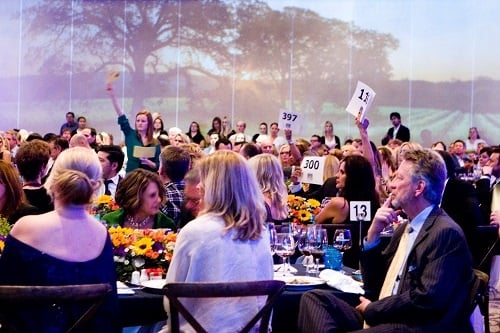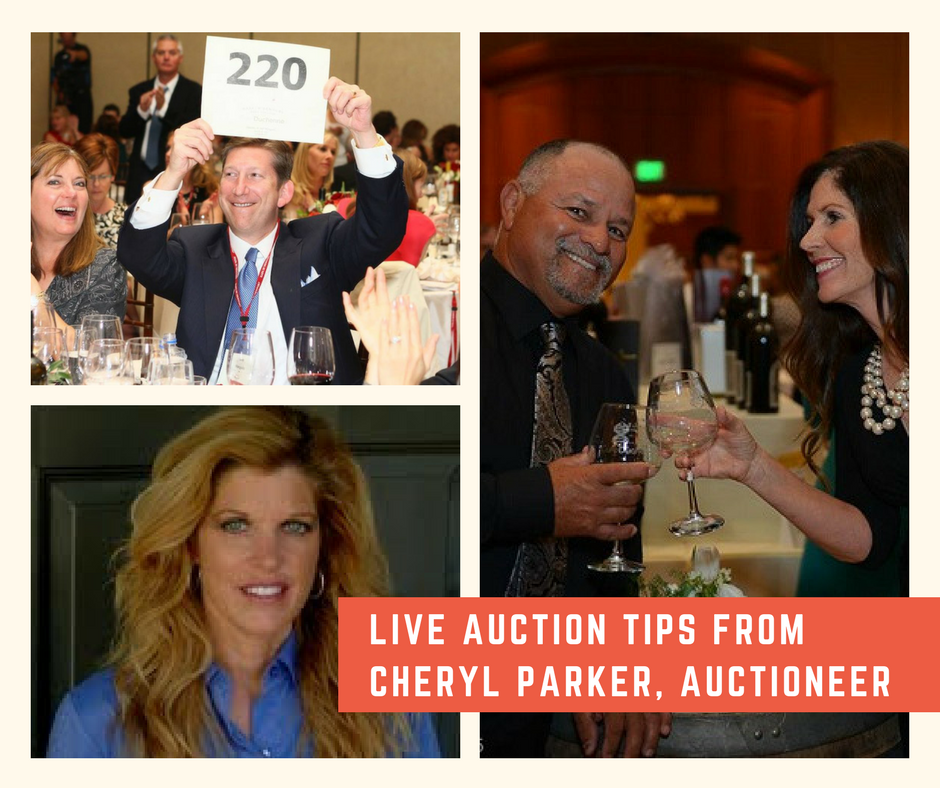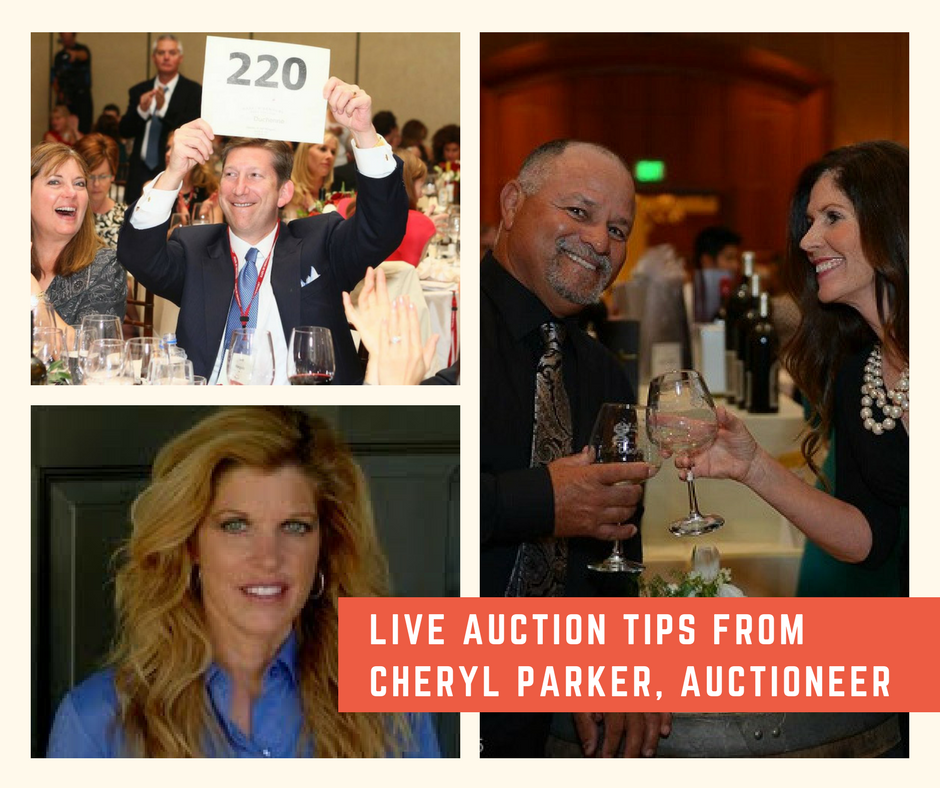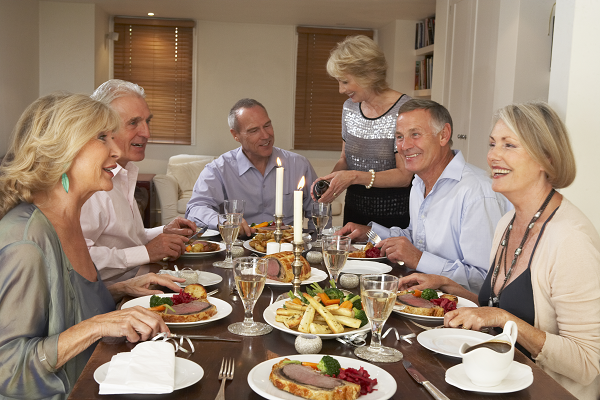When it comes to charity auctions, many organizers simply “don’t know what they don’t know.” Unfortunately, a lack of professional expertise is the #1 reason events fall short of their revenue goals.
To help provide the expertise needed for success, we interviewed Cheryl Parker, certified benefit auctioneer specialist in San Diego, Calif., for a recent episode of event fundraising podcast Events with Benefits. Parker shares her simple – yet often overlooked – strategies for generating as much revenue as possible at auction events.
Check out a portion of the useful conversation below, then listen to the full podcast to request your FREE copy of what clients call the ‘event planning Bible’: a document with over 70 pages of proprietary strategies and concrete tips for a record-breaking auction.
Q: As you know, an inherent part of nonprofit work is directing as many pennies as possible to the cause. What would you say to those who think they just can’t afford to retain a professional benefit auctioneer?
This is a very common mindset. Auction organizers see a proposal, they see a fee, and think, ‘That money could be going towards our new building, the new after school program.’
My advice: It’s time to think like a business. Instead of focusing on the fee, look at how much an auctioneer can bring to the event. And, just as importantly, consider what you could lose without an auctioneer.
If you’re willing to put out money for flowers, a DJ, and other expenses that don’t bring revenue on day of an auction, that much more could be put towards an investment like a skilled auctioneer.
If your auction is on the decline, finding the right auctioneer is a game changer. My clients often tell me, “We’d been slowly losing money all these years. The fee we paid you this year, we made back tenfold.”
Q: Speaking of “thinking like a business,” how important is it to pre-plan your event?
No successful business ever launched without a business plan.
Many nonprofits look at events as a social gathering, but it’s important to outline how funds will be raised. Where can we maximize opportunities?
Most auctioneers, from the moment you book, will walk with you every step of the way to help you make more money. Personally I am laser-focused on the auction portion of your event, because that’s my job.
Q: On our blog we’ve discussed incorporating extra income streams into events – raffles, games, and so forth. What are your thoughts?
First, avoid trying to pack too much in. The last thing you want is guests feeling nickel and dimed.
That said, if you can add additional opportunities and be creative with it, people won’t realize they are being asked for money. Raffles, games, fund-a-needs, plus of course the live and silent auctions, are all ways to get the most out of your audience and event.
Be well-rounded, but don’t squeeze in so many things that you dilute where the focus should be: the areas that bring in top dollar.
Bonus tip: If you can sell a raffle prize in a silent auction, put it in the auction. It’ll bring in more money.
{{cta(‘abf42219-dfca-4206-aa00-00c4f7e24a0b’)}}
Q: How many live auction items do I need at my event?
There is no set number – it’s about the quality of the items.
Most events stick to 7 to 12 items. That said, I do one event where they have over 60 items every year. It’s fun, energetic and exciting. I’m able to create an environment where people get into bidding wars – and it’s great entertainment for those who aren’t actively participating.
Q: What are some popular items today?
Off the top of my head: dinner parties at people’s homes. Restaurants may donate food to a private host, or you can get a professional chef to come into a home and prepare a dinner. This is a very open ended opportunity to make quite a bit of money.
Another big seller is travel packages.
Years ago I ran into plenty of nonprofits that firmly refused consignment, but that landscape has changed drastically. Many organizations don’t realize they can use packages with no risk, and it’s a turnkey package for the buyer, meaning the trip is ready to go and fulfilled by the provider. All they do is collect the profits.
{{cta(‘e2710835-5b9d-4251-ba97-49dbda4c030c’,’justifycenter’)}}
I’ll recommend a few trips depending on the type of organization. New York packages are bestsellers, as are trips to wineries. Anything you can do that’s a one-of-a-kind experience works great – bidders are wowed that items like tickets to the Super Bowl are available for them to buy.
As for items to reconsider, jewelry is very subjective – is it too gaudy, is it tasteful. If you have a donated necklace worth $10,000, for example, I advise asking your committee for opinions. If everyone likes it, put in the live auction. If only one person likes it, the silent is your best bet.
{{cta(‘ace6904c-d5a9-4f23-afcc-36e09cf0f71e’,’justifycenter’)}}
Q: You mentioned including exciting trips like a New York or Napa Valley getaway. A good portion of our readers represent small organizations. Can their donors really afford vacation packages?
Never underestimate capacity of buyers in the room.
I work with a lot of school auctions, and they often say, “We don’t have any parents that would spend that kind of money.” My response: You really don’t know until you put out items worth that kind of money.
People are very peer-driven during an event. They like to win, and you’ll always be surprised at what someone will pull out even if you think there’s no one there to do it.
Again, focus on the type and quality of the item, not the dollar value.
{{cta(‘0d771a74-45f8-4fa7-800e-0e6d53ecee96′,’justifycenter’)}}
When I encounter resistance to this idea, I advise putting a few trips in the silent auction and see what happens. There’s no risk to doing so, and if it does get bids, sometimes I’ll yank it from the silent and put it right in the live auction. This incredible item gets the audience’s individual focus, and that’s guaranteed to make more money.
Q: Got any tips for ordering your items in the live auction?
To heat bidding, it’s all about building energy in the room. It’s important not to start with an item that falls flat on its face. If it does, move on to the next item – you can go back to it later.
{{cta(‘2493c44f-abf9-49d3-8678-cf7059e8567b’,’justifycenter’)}}
Q: How do you “double up” on a live auction item?
I have a proprietary planning guide I give to all my clients that discusses this important strategy.
Simply put, every time your committee asks for a donation, ask for two. That way, in the live auction, I can sense when I’m about to lose the second bidder, and stop the bidding war. I’ll then say I want the organization to make a lot of money, and have potentially two to sell. I’ll then sell both at the lower price.
This is especially easy with no-risk or consigned items, which can be purchased virtually limitless times.
{{cta(’44cadd6e-577b-41e7-bae3-b8031778bf73′,’justifycenter’)}}
Q: What size events should hold fund-a-needs (also known as special appeals, cash appeals, or paddle raises)?

There’s no reason, in a setting like a fundraising auction, that a nonprofit shouldn’t ask guests for money. Best of all, you’re not the one asking for money – I am.
At an event, people want to donate and get involved. Personally I have a very unique structure to my cash appeals that makes a very emotional connection.
Q: Wow, every event! Tell us a bit more about how you execute an effective fund-a-need.
In 95 percent of events, I do the live auction first, and here’s why. During the live auction, there’s so much energy. People get excited, they’re outbidding each other. After I’ve sold last item, I’ll have somebody with an emotional or physical connection to the appeal speak for a minute or two. That draws in the crowd and sets up the appeal.
However, if the fund-a-need is the main crux or highlight of the event, I’ll lead with it.
As far as how to conduct a special appeal, I work with organizations very closely on this.
The most important thing is that the nonprofit is able to link a specific outcome to the different giving levels.
I’ve been to many events that I felt left something on the table because all they did was call out numbers: “Who’s going to donate $5,000? Who’s going to donate $3,000? How about $1,000?” That’s the old style.
Now you have to engage the audience and give them ownership over what you’re going to be asking for. What do these items cost? Where is this money going to go?
{{cta(‘3dd4718e-77dc-49d5-a5e6-0b3ccde90e1b’,’justifycenter’)}}
Of course, I’m careful to say, the money can go towards things, since I don’t want to lock the organization into spending a particular bid or pledge toward an item. But linking bids to particular items, services or programs (think: new iPads for a classroom) gives people a concrete reason to raise their paddles.
An added bonus is that people are incentivized to bid several times. When I get down to lower levels, a higher level donor can put their hand up again. The way I structure the cash appeal gives the chance for multiple pledges, and engages more donors of all giving capacities.
Q: Thank you so much for providing these amazing, actionable ideas for our readers. How can our readers get a copy of your planning guide?
My proprietary event planning guide is over 70 pages of tips and strategies that work to make auctions better, suggestions for getting donations and more. My clients call it their Bible because it’s helpful every step of the way to put on a profitable auction. I’m happy to offer it free of charge to all of your readers who listen to my episode of Events with Benefits.
Check out Parker’s full podcast episode below, then visit the podcast site for instructions to request your guide in the show notes.
{{cta(‘639b168b-df3f-4dd6-b2ef-ae20cd598be3′,’justifycenter’)}}


